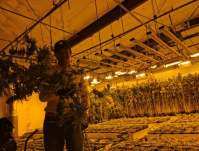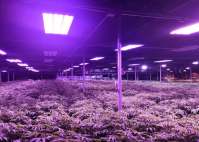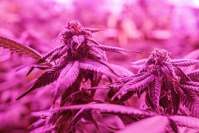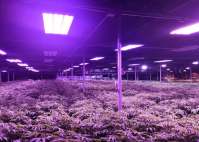The effect of LED grow light quality on grows
Different light qualities or wavelengths of light have significantly different biological effects, including different effects on the morphological structure and chemical composition of grows, photosynthesis, and organ growth and development.
Red light: Red light generally inhibits internode elongation of grows, promotes tillering, and increases the accumulation of chlorophyll, carotenoids, soluble sugars and other substances. Red light promotes the growth of leaf area and β-carotene accumulation of pea seedlings; lettuce seedlings are pre-red light and then applied with near-ultraviolet light. It is found that red light can enhance the activity of antioxidant enzymes and increase the content of near-ultraviolet absorbing pigments, thereby reducing near-ultraviolet light. Light damages lettuce seedlings; a full-light experiment on strawberries found that red light is beneficial to increase the content of organic acids and total phenols in strawberries.
Blue light: Blue light can significantly shorten the pitch of vegetables, promote the horizontal expansion of vegetables and reduce leaf area. At the same time, blue light can also promote the accumulation of grow secondary metabolites. In addition, experiments have found that blue light can reduce the inhibition of red light on the photosynthetic system activity and photosynthetic electron transport capacity of cucumber leaves. Therefore, blue light is an important factor affecting the photosynthetic system activity and photosynthetic electron transport capacity. There are significant species differences in the blue light needs of grows. Strawberry was supplemented with postharvest light and found that 470nm in blue light of different wavelengths had a significant effect on the content of anthocyanins and total phenols.
Green light: Green light has always been a controversial light quality. Some scholars believe that it will inhibit the growth of grows, cause short grows and reduce vegetable production. However, there are also many studies on the positive effects of green light on vegetables. A low proportion of green light can promote the growth of lettuce; adding 24% of green light on the basis of red and blue light can promote the growth of lettuce.
Yellow light: Yellow light basically inhibits grow growth, and because many researchers incorporate yellow light into green light, there are very few literatures about the effect of yellow light on grow growth and development.
Ultraviolet light: Ultraviolet light generally shows more damage to organisms, reducing grow leaf area, inhibiting hypocotyl elongation, reducing photosynthesis and productivity, and making grows more susceptible to infection. However, appropriate supplementation of ultraviolet light can promote the synthesis of anthocyanins and flavonoids. By adding a small amount of UV-B to the postharvest cabbage to promote the synthesis of its polyphenols; postharvest UV-c treatment can slow down the fruit of red pepper Glue dissolution, quality loss and softening process, thereby significantly reducing the spoilage rate of red peppers, extending the shelf life, and can promote the accumulation of phenols on the surface of red peppers. In addition, ultraviolet light and blue light affect the elongation and asymmetric growth of grow cells, thereby affecting the directional growth of grows. UV-B radiation causes dwarf grow phenotypes, small and thick leaves, short petioles, increased axillary branches, and changes in the root/shoot ratio.
Far-red light: Far-red light is generally used in proportion to red light. Due to the structure of the photosensitive pigment that absorbs red light and far-red light, the effects of red light and far-red light on grows can be mutually transformed and offset each other. When the white fluorescent lamp is the main light source in the growth room, LEDs are used to supplement far-red radiation (emission peak 734nm), the content of anthocyanin, carotenoid and chlorophyll is reduced, while the fresh weight, dry weight, stem length, leaf length and leaf width of the grow increase . The effect of supplementing FR on growth may be due to the increase in light absorption caused by the increase in leaf area. Arabidopsis thaliana treated with low R/FR has larger and thicker leaves, increased biomass, and accumulation of more soluble metabolites, which improves cold resistance than that treated with high R/FR.
The effect of light quality on grow tissue culture
During the process of grow tissue culture, seedling morphology and physiological and biochemical changes are regulated by many environmental factors (light, temperature, humidity, etc.). Among them, light plays an extremely important role in the growth and differentiation of grow cells, tissues and organs. In the process of grow tissue culture, each morphological stage from exgrow callus induction to formation of complete grows is affected by LED light quality, and different tissue culture stages of different grows have different responses to light quality.
The effect of LED grow light quality on callus induction, growth and differentiation
Callus culture is an important part of grow in vitro culture. The study found that 100% red light has the highest induction rate for orchid callus, and the growth effect of callus is the best when the ratio of red to blue light is 3:1. Monochromatic red LED promotes the formation of callus of Anthurium andraeanum, but as the proportion of blue light increases, the induction rate of leaf callus gradually decreases.
Red light and white light promote the induction of callus of pepper cotyledons, while green light and blue light show inhibitory effects;
Yellow light is beneficial to the induction of callus from the hypocotyl of radish, while blue light promotes the induction of callus from the cotyledon;
Significantly promote the induction and proliferation of garlic callus under red light;
The blue light has the strongest effect on promoting the differentiation of callus of Chinese yam;
Yellow light is most conducive to the proliferation of grape callus, followed by green light;
The blue light is beneficial to the induction of cotyledon callus, and the red light is beneficial to the proliferation of callus;
The effect of different light quality on callus induction varies with grow species or exgrow types.






